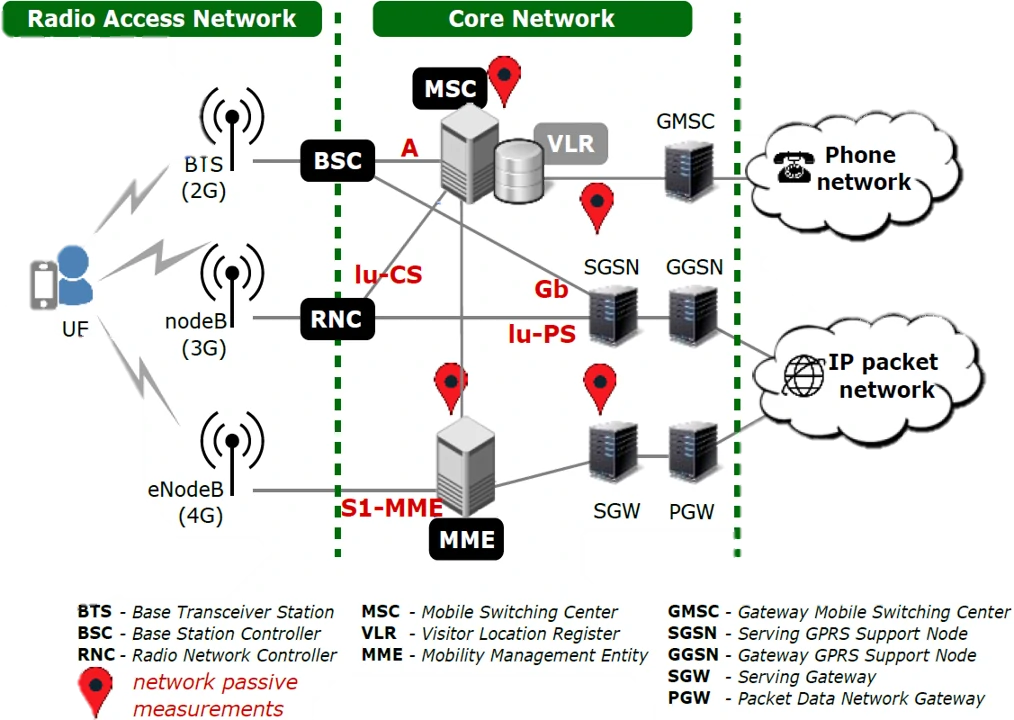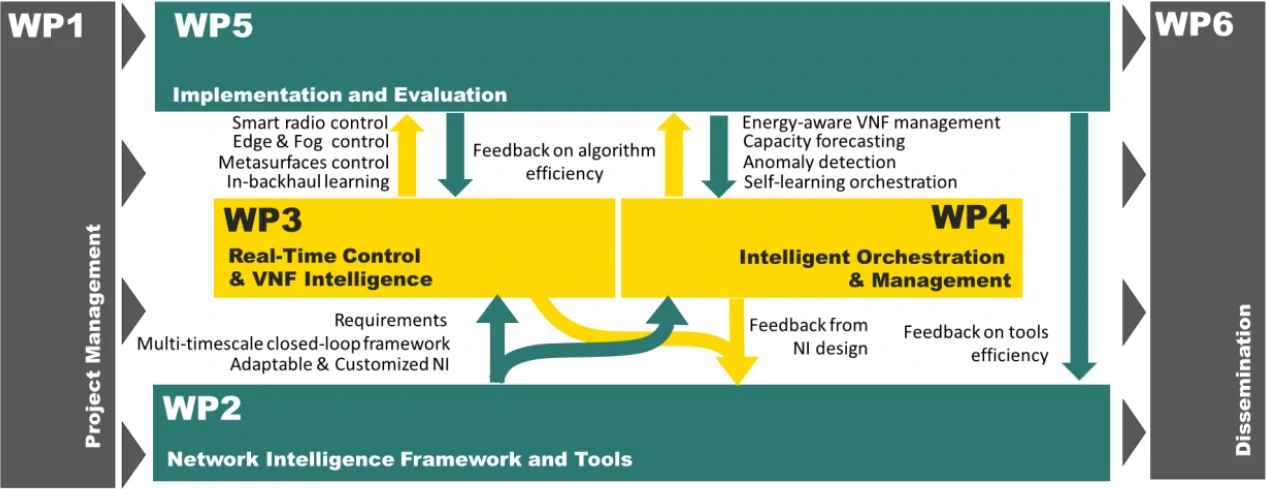Methodology
The DAEMON project will be executed over five sequentially aligned phases. Each phase focuses in one objective. The proposed methodology aims to validate the project outcomes in relevant environments so as to proof the commercial take-up of its technology and network products.

As represented in letters used in the previous figure:
- Lay the foundations for a NI-native B5G architecture.
- Devise innovative approaches for the design of a NI that responds to the specific needs of networking tasks.
- Leverage on current approaches to develop new NI algorithms that support eight critical and innovative B5G functionalities, which, once embedded in the project NI-native architecture, allow meeting the different key performance indicators.
- Demonstrate the advantages of the new NI design and integration through extensive validation.
- Encompass all measures adopted to ensure impact.
Elaborating evaluation (D), DAEMON uses a comprehensive validation methodology, based on two complementary approaches:
- Real-world experiments: it will showcase how NI-driven zero-touch network management can yield substantial performance gains and savings in resource usage efficiency or energy consumption, with credible proofs-of-concept in realistic but controlled environments.
- Data-driven evaluations: its partners will have access to substantial volumes of mobile traffic data, which is paramount to the proper training of the NI algorithms, and ensures that such algorithms will be trained and tested in realistic conditions. DAEMON will also feed the measurement data to digital-twins implemented into simulation and emulation sandboxes.
The DAEMON validation methodology includes evaluations that use either the experimental sites or measurement datasets. The project real-world experimental validations will be carried out in the four sites:
- Radio: This site, located in Dublin, Ireland, comprises a medium-scale testbed with a large number of software-defined radios, as well as computing infrastructure to host baseband units and additional radio monitoring equipment.
- Orchestration: This is a multi-location evaluation site, with computing and networking infrastructure geographically distributed across three physical locations in Spain, Belgium and Greece, interconnected through tunneling technologies. The goal is to provide a testbed with distributed computing fabric to experiment with management and orchestration platforms and algorithms.
- Management: This site is in Spain, and has (i) experimental platforms for virtualized core and radio emulation, and (ii) a production platform – in collaboration with Telefonica Business Solutions operations– to study interconnection models of mobile operators worldwide.
- Edge: This site, located across 30 Km of highway in Belgium, consists of 8 Road-Side Units (RSUs) and one V2X-capable vehicle, to test NI at the network edge of a real high-mobility scenario.
The validation of NI solutions at scale requires large amounts of data to train and validate the learning algorithms. However, too often in the literature AI solutions are evaluated in non-realistic data setups that include simplistic traffic generated from random distributions. Instead, DAEMON takes a strong data-driven approach for NI evaluation that ensures the credibility of the results. The data-driven approach will build on two large-scale datasets:
- Through the TID partner, DAEMON will be granted access to measurement data collected in the UK within the operational of O2, a Mobile Network Operator (MNO) with more than 25% market share in that country. The available datasets comprise hundreds of network KPIs for every cell site and radio sector, as well as exhaustive mobile core signaling logs and KPIs, gathered on demand.
- The OTE partner is the leading mobile network operator in Greece, with close to 50% of the total customers in the country. The participation of OTE in the project will grant access to nationwide datasets of network KPIs such as per-cell served users, traffic, throughput, latency, or jitter.

The monitoring infrastructures deployed by the two operators are in fact fairly similar, as illustrated the previous figure. They support 2G, 3G and 4G technologies, while 5G probes will be incorporated within the project
timeline. Commercial solutions allow monitoring the Mobility Management Entity (MME), the Mobile Switching Center (MSC), the Serving GPRS Support
Node (SGSN) and Serving Gateway (SGW), and the individual cell sites. The MNOs collect control plane information for both voice and data traffic from the total population of devices connected to the radio network as well as KPIs of cell sites. For every cell site, MNOs have detailed information about location, radio
technologies, or radio sectors, and gather KPIs like cell/user throughout, resources usage. DAEMON plans a set of six evaluations that will allow assessing the performance of the developed NI-assisted functionalities:
- NI for sustainable virtualized RANs: to demonstrate real-time control and non-real time orchestration of vRAN services and resources.
- NI for VNF placement and control: to implement and demonstrate NI solutions that support network slice management and orchestration operations.
- NI for real-time anomaly detection: to validate tailored NI solutions for anomaly detection both in controlled environments and in a production core network.
- NI for Edge orchestration: to implement and deploy the NI-assisted solutions for service orchestration and resource allocation algorithms in the Edge micro-domain.
- NI for automated anomaly response: to test NI-assisted solutions for anomaly response in very large-scale settings.
- NI for capacity forecasting and self-learning: to validate the NI solutions designed for long-timescale operations, i.e., MANO, VNF placement and the associated resource allocation.
In addition to advancing the TRL of the NI-assisted functionalities, DAEMON also aspires at advancing the TRL in terms of industrial adoption of NI technologies for network management, especially through open source and standards.
The ambitious objectives of the project, as well as and the implementation of the methodology that allows achieving them, require knowledge from different branches of telecommunications engineering: applied machine learning for networking, network architectural design, network software design and data-driven network analysis. The DAEMON project brings together partners that have outstanding track records in all of these different facets of telecommunications engineering, which ensures DAEMON‘s perfect viability.
Work Plan
We propose a work plan divided into different Work Packages (WPs). Three WPs are devoted to the design and implementation of an NI-native B5G network architecture (WP2) along with a wide range of coordinated NI-assisted functionalities across different domains and timescales (WP3 and WP4). One additional WP (WP5) is devoted to carrying out a thorough evaluation campaign across different facets: emulation, simulation, experimental Proof-of-Concept (PoC) and demonstrations, and analysis over large-scale datasets. These WPs interact with each other through several iterations where feedback is provided by one WP and then accommodated by the others, in a continuous development process to ensure full consistency. This is illustrated in the following figure.

Overall, the work plan is structured into 6 WPs, 4 of which correspond to the technical WPs mentioned above:
- WP1 (Project Management) handles the administrative, technical, ethics and data management of the project.
- WP2 (Network Intelligence Framework and Tools) lays the foundations for the technical work of the project, building to this end an architectural framework and a NI-based toolset to support WP3 and WP4.
- WP3 (Real-Time Control and VNF Intelligence) designs and develops NI-assisted functionality for B5G problems in the area of real-time control and network function intelligence: compute-aware radio scheduling, edge/fog resource control, RIS control and in-backhaul support for service intelligence. As depicted in the previous figure, WP3 provides feedback to WP2 to ensure the alignment with DAEMON’s NI framework and tools.
- WP4 (Intelligent Orchestration and Management) designs and develops NI-assisted functionality for B5G problems in the area of service and resource orchestration and management: energy-aware VNF placement, capacity forecasting, automated anomaly detection and self-learning management and orchestration. Like WP3, and as depicted in the previous figure, WP4 provides feedback to WP2.
- WP5 (Implementation and Evaluation) is devoted to performing a thorough evaluation of the NI-assisted functionality developed within WP3 and WP4, and is responsible for each of the six demonstrations comprising both integrated testbeds, data-driven evaluations using large-scale nation-wide datasets, and simulation and emulation-based experiments introduced in the methodology preface. WP5 provides feedback to WP2, WP3 and WP4.
- WP6 (Exploitation and Dissemination) plans, coordinates and executes all communication, dissemination and exploitation activities associated with the developments in the technical work packages (WP2 to WP5).


